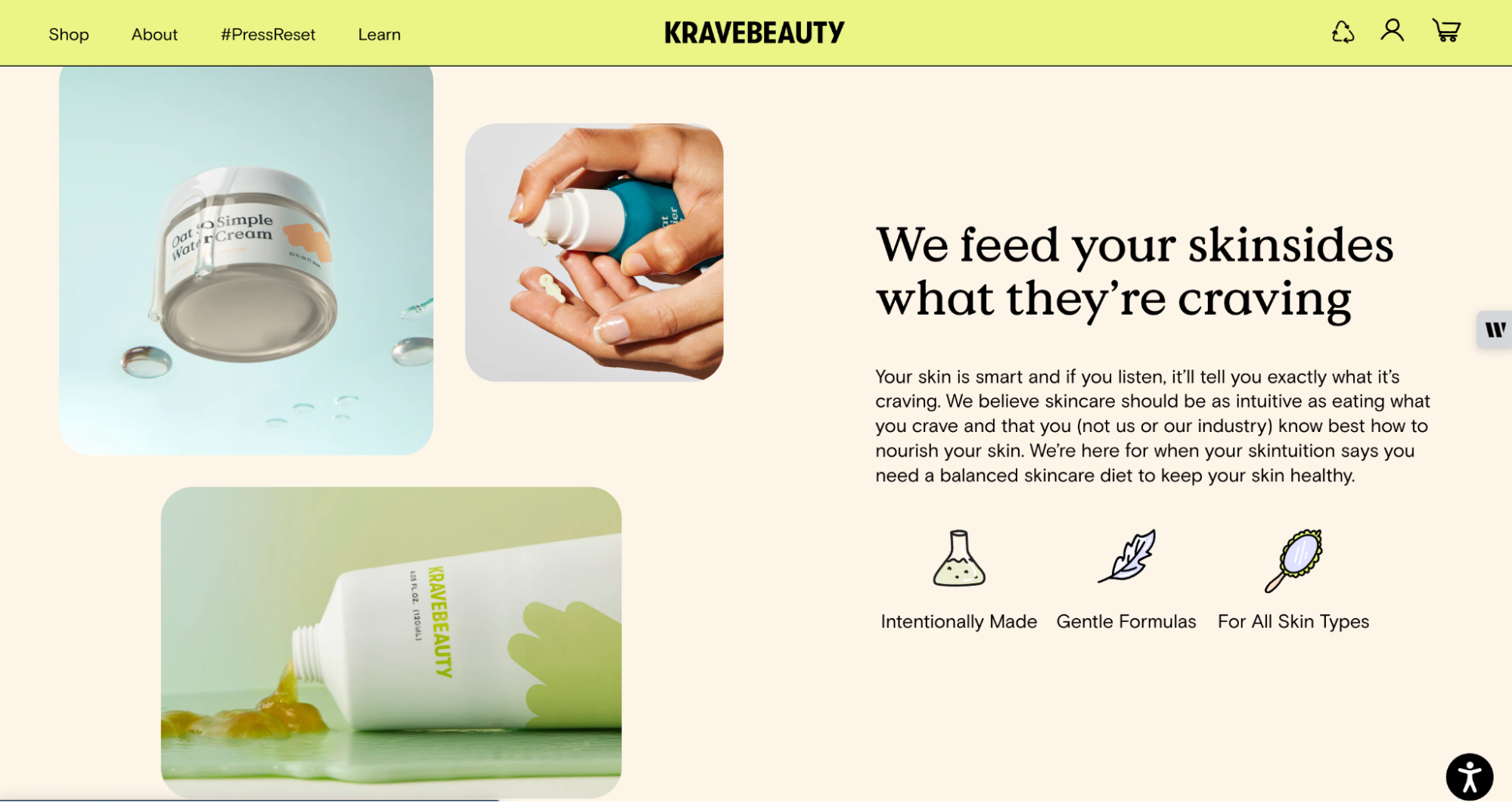Imagine this: While scrolling through your favorite creator’s content, you come across an article titled “10 Must-Have Items for Solo Travel.” As a frequent traveler, your interest is piqued. One of the items on the list is pepper spray to add to your self-defense kit.
Intrigued, you start looking up “long-lasting pepper sprays.” You head over to a brand’s website and discover it’s headed by a mother-daughter duo committed to making travel safer for women. You return to the site the next day and buy the product.
This scenario describes inbound marketing at work. Customers discover something interesting, read up on it, and are subconsciously persuaded to buy. Inbound marketing differs from outbound marketing by focusing on attracting customers through relevant and helpful content rather than pursuing them through sales-driven messaging.
Ahead, learn about inbound marketing in detail: what it is and how it’s different from outbound marketing, plus seven winning ways to implement your own inbound strategy.
What is inbound marketing?
Inbound marketing is a digital marketing strategy designed to draw your target audience into your business. Inbound marketing gently persuades customers to buy—whether through blog articles, user-generated content (UGC) on Instagram, or LinkedIn carousels. It works because users get exposed to your product without being bombarded with “buy now” messaging.
Why is inbound marketing important?
Inbound marketing is marketing via attraction—you create and share content that pulls people in, making them come to you, rather than you chasing them.
At a time when customers are overwhelmed by too many options, inbound marketing helps you build trust. When you create content to educate (and not immediately sell), your audience will, in turn, think of you when they need something. According to research, consumers are 131% more likely to buy from a brand immediately after they consume educational content.
Since every customer approaches a product from a different point of view, inbound marketing helps you proactively meet them wherever they are in their purchase journey or thought process. For example, a backpack brand might offer hiking tips for first-time hikers, but also gear recommendations for advanced trekkers.
How does inbound marketing work?
The best inbound marketing efforts usually follow a four-step process: attract, convert, close, and delight. This works because it meets customers at different stages of the customer journey.
1. Attract
The first phase of inbound marketing involves exposing people to your brand and getting them to your website. Here are three examples:
- Creating and hosting content: Develop content that appeals to your target audience, such as blog posts, infographics, videos, and podcasts. Each piece should offer value by solving a problem, answering a relevant FAQ, or offering a unique perspective.
- SEO (search engine optimization): Optimize all your content for search engines with relevant keywords and meta descriptions, and structure your content to enhance visibility in search results.
- Social media engagement: Use social media platforms to promote your content and engage directly with your audience.
2. Convert
This phase begins once potential customers have arrived at your digital store. The “Convert” stage involves turning website visitors into leads by collecting data through forms and interactive content. You can engage prospects with relevant landing pages, followed by persuasive calls to action (CTAs). Popular CTAs include “Sign up for an email list,” “Start a free trial,” or “Book a demo.”
3. Close
The third phase is closing the sale by personalizing outreach and marketing to establish a vendor-customer relationship. Strategies such as personalized email campaigns, occasion-specific discounts, and exclusive content can move the needle.
4. Delight
Your goal isn’t to win every single customer transaction—it’s to build a loyal following of long-term customers who like and recommend your products and services. To delight a customer, follow through on your marketing with exceptional customer experience. This includes:
- Offering strong product quality and packaging to exceed customer expectations
- Providing good customer service so your customers can find answers to their most nagging questions
- Engaging in social media dialogue to understand customer needs and behaviors
Now that we’ve discussed how inbound marketing works, let’s dive into how it differs from outbound marketing.
Inbound vs. outbound marketing
Inbound marketing is a long-term strategy where you invite prospects to engage with your business. Outbound marketing is when you proactively reach out to potential customers to persuade them to make a purchase.
Here are four key differences between inbound and outbound marketing:
| Inbound Marketing | Outbound Marketing | |
|---|---|---|
| Objective | To attract customers organically | To actively reach out to potential customers |
| Method | Content creation (blogs, how-to guides), search engine optimization (SEO), and social media engagement | Paid advertising (PPC), direct email campaigns, and cold calling |
| Customer Interaction | Customers find the store through search engines, content, or social media shares | Store initiates contact with customers through targeted ads or direct communication |
| Conversion Strategy | Customers convert based on perceived value and authority over time | Customers convert immediately because of offers, discounts, or urgent calls to action |
Types of inbound marketing
Inbound comes in a variety of types and formats. Here are five of the most common ones:
Content marketing
Content marketing involves creating and distributing valuable, relevant, and consistent content to attract a clearly defined audience. This can include blog posts, ebooks, and white papers.
SEO
SEO is the practice of optimizing your website to make it more likely to rank high in search engine results. For example, you might use keywords strategically, build a mobile friendly site, and improve loading speeds. This improves the site’s visibility and attracts more visitors organically.
Social media marketing
Social media marketing involves using social media platforms to create engagement and community around your brand. This can involve sharing content, engaging with followers, and participating in conversations to build trust and authority.
Email marketing
Email marketing involves building a list of subscribers and nurturing them with customized content and offers. Ideally you would segment your audience, create automated sequences, and personalize messages with subscriber-specific data.
Webinars and online events
Webinars and online events offer an interactive format for you to connect directly with your audience and build relationships. Brands can create video engagement by answering their customers’ most pressing questions and even inviting them onto the virtual stage.
7 inbound marketing strategies to drive success
Given the vast array of channels and mechanisms, inbound marketing can seem daunting. However, abiding by these seven strategies can help you stand out and sell.
1. Create effective content
Content underlies every single marketing activity—social media campaigns, website strategy, and even outgoing text messages. Great content has the power to make your brand distinct and memorable.
“When you create good content, your audience knows it. You become their go-to source. They trust you and your advice,” says Aarushi Singh, content lead at Uscreen. “Soon enough, they’re willing to sign up for your product or vouch for it, creating social proof for your brand. It’s a win-win.”
Invest in content creation not just in terms of capital and team resources but also by sourcing experts and digging deep into everything your audience cares about.
“Think deeply about what a business owner would want to learn about and create multiple blogs around those topics,” says content marketing specialist Gregory Ciotti. “Cover every intricacy, every nuance, and every potential pitfall—so your customers feel like you have their back.”
2. Optimize for organic search
When people reach your website on their own (without targeted ads or CTAs), they trust you more. Optimizing for search ensures that people can find you organically.
Optimizing for search involves using relevant keywords that align with user queries, structuring your website to improve user experience with clear navigation and fast loading times, and ensuring your content is accessible to all users. This way, you ensure that when users search for information related to your products or services, your site appears prominently—eventually increasing organic traffic.
According to Lia Parisiyan, former VP of content marketing at Insider, a customer experience platform, “When you optimize content with relevant keywords, structure your site to be user-friendly, accessible, and fast-loading, you increase the likelihood that people looking for information about your products or services will find your content.”
3. Build a social media presence (and start social selling!)
People now turn to social media to find new products because it nails two things: word-of-mouth and visual context. This is why having a social media presence is a non-negotiable component of inbound marketing.
It’s typically free to open a social media account and build communities, interact with followers, and observe how your target audience behaves. Social media platforms also help you share and promote content you’ve built on other platforms. For example, you can repurpose a website blog as an Instagram carousel. Promoting your products on social media is a practice known as social selling.
“Social selling works because it’s the closest we can get to scaling word-of-mouth,” Aarushi says. “People inherently trust their peers over brands who are pushing them to buy. And showing up on social places where your target audience hangs out is a way to sell without being obvious or pushy.”
4. Build communities
Communities help you establish authenticity and trust, which turns into traffic. Open communities on social media platforms and support forums allow you to demonstrate expertise and build relationships. Private communities help you build a premium experience for your audience with exclusive content.
For example, Bandit, a New York–based running apparel company, started building a community even before it launched a product. When asked how he led with a community-first inbound approach on Shopify Masters, Tim, Bandit’s co-founder, said, “We took the mundane moments of running in our content and showed customers actually how special and fun they are. That brought them all together.”
5. Show up as yourself
Shifting to a more personal and authentic voice means vocalizing the good, the bad, and the ugly about your brand. And it’s a risk that can have a high payoff, because 88% of consumers say authenticity is important when deciding which brands they like and support.
“The shift toward authenticity is real, pun intended, because consumer standards have evolved during and after the pandemic,” Lia says. “Content that reveals the human side of a brand, such as live videos, behind-the-scenes looks, and personal stories, tends to connect more deeply with audiences.”
6. Keep your customer front and center
At a time when most brands are creating customer-specific marketing assets, customers have grown to expect content that is personalized to their own needs and desires. For example, a product recommendation email based on past purchases may perform better than a generic newsletter that may not apply to them.
7. Offer a newsletter
Even though creating an email newsletter falls under creating great content, here’s why we’ve given it its own spot: Unlike social media posts or blogs, newsletters reach your audience directly in their inboxes.
You can start by creating an email list and sending periodic newsletters to your loyal customers, featuring various types of content, such as:
- Product announcements
- Special offers
- Customer success stories
- Educational tips
- Behind-the-scenes looks
Some of the best newsletter content has no direct connection to commerce. Brands keep customers engaged by sharing articles, essays, videos, and podcasts on interesting and narrowly related topics.
Inbound marketing examples
Let’s dig into a few examples of brands doing inbound marketing well. Each example we discuss uses at least three of our seven top strategies.
Krave Beauty

Krave Beauty’s inbound mechanism focuses on authentic, community-focused social selling.
Liah Yoo, founder of Krave Beauty, highlighted her struggles with adult acne that helped her build an online following. Because she is vulnerable about her own frustrations, her audience trusts her to handle theirs.
Liah Yoo discusses the topic in detail on Shopify Masters. “Community gets built really easily around a shared problem,” she says.
Krave Beauty also creates content to address skin care myths, reviews commonly recommended products, and encourages customers to develop a simple but workable skin care regimen.
“If you can create content with helpful, tactful information, people will keep coming back for more. Developing personal expertise makes your posts engaging and earns the trust of your target audience,” Liah says.
Takeaway: When your audience resonates with your challenges, you can build a more engaged following.
Ryze

Ryze, the mushroom coffee brand, engages audiences where they spend a lot of their time: on social media platforms like Instagram and Facebook.
It’s tapped into the trend of creating succinct video content, known as Shorts on YouTube and Reels on Instagram, to attract and engage thumb-scrollers. But it goes beyond traditional unboxings and promotions, and gets influencers to share honest reviews.
Ryze also collaborates with wellness and health influencers to co-create content on mental clarity, energy boosting, or the effects of caffeine withdrawal.
Overall, Ryze’s inbound marketing strategy is effective because it aligns with the modern consumer’s desire to discover products organically rather than through traditional advertising. It doubles down on authenticity by getting customers to talk about their products.
Takeaway: There are multiple ways to build authentic content. You can partner with influencers, give customers an incentive to share their stories publicly, and ask different team members to show how they use your products.
ConvertKit

ConvertKit, a marketing platform, offers resources on its blog to help entrepreneurs (specifically creators) build better and more profitable businesses.
“When I decided to start a newsletter, I sifted through the typical top 10 list on Google and looked up the websites,” says Aarushi Singh, content lead at Uscreen. “As I browsed blogs, landing pages, templates, products, workflows, and funnels, I realized that ConvertKit offered a lot of free and ready-to-use resources. This made me feel like they genuinely cared about my goals and the challenges I faced as a creator, first, and as a prospect, second. They were committed to my entire journey. So when I was ready to take the plunge, I turned to ConvertKit.”
“We believe that keeping our customers as the source and hero of our content ideation helps our audience identify themselves in the content they’re engaging with—which hopefully leaves them eager to try our platform for themselves,” says Dani Stewart, ConvertKit’s content lead.
Takeaway: Be thoughtful about what you deliver to prospects. You can’t create content just because it’s a “top strategy”—you have to constantly add value and be as invested in their success as you are in your own.
Defining your inbound marketing strategy: Final thoughts
The genius of inbound marketing is that, while it takes a lot of upfront legwork, your efforts pay off for years. Inbound can drive website traffic without spending a dollar on pay-per-click marketing. It’s also one of the most surefire ways to build trust and long lasting relationships.
Inbound marketing strategies FAQ
Who uses inbound marketing?
Ecommerce retailers and digital marketplaces use inbound marketing to attract and retain customers through content, social media, and email marketing.
What are the keys to a successful inbound marketing strategy?
- Know your target audience.
- Create relevant and valuable content.
- Optimize your website and social media platforms for conversions.
- Use strong CTAs.
- Measure your performance.
What are some examples of inbound marketing strategies?
- Creating relevant content on your blog or social media profiles.
- Search engine optimization (SEO).
- Creating high-quality content designed to generate traffic from search engines.
- Creating video content on social media.
- Running engaging ads.
What’s the key to a good inbound marketing strategy?
Ultimately, for inbound marketing to work, you need to invest in creating relevant content designed for your target audience and share that content where your target audience will see it. For long-term success, you must also consistently test and tweak your inbound strategy.







